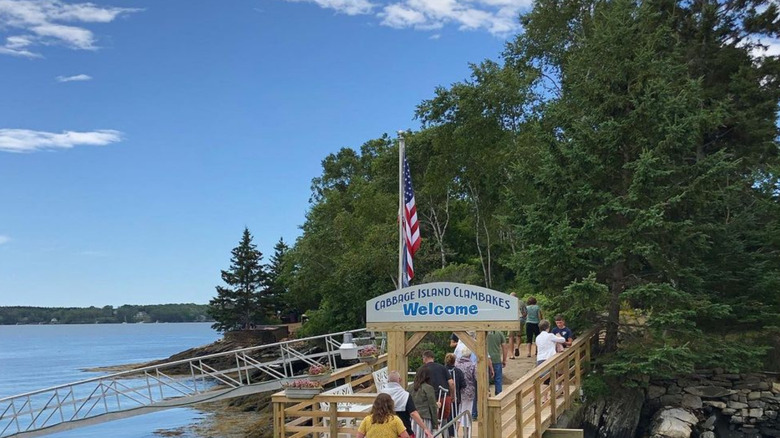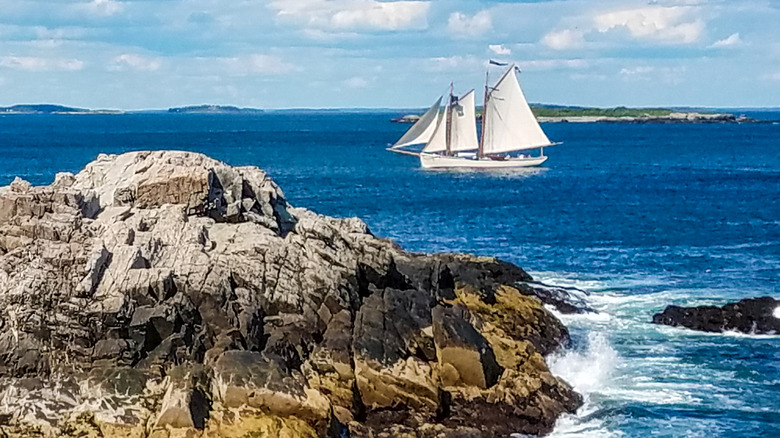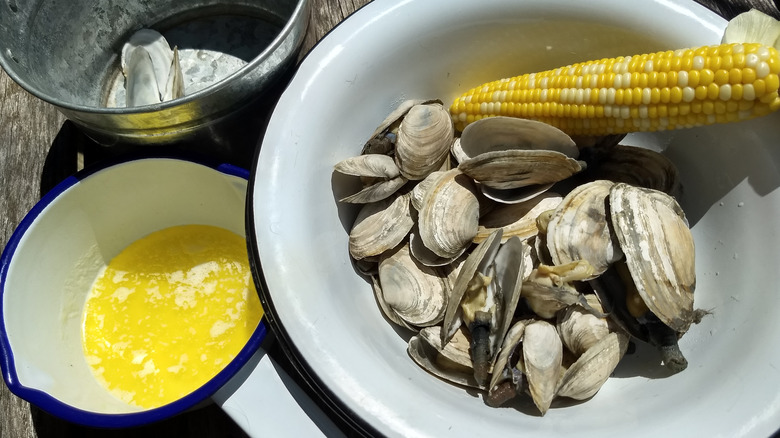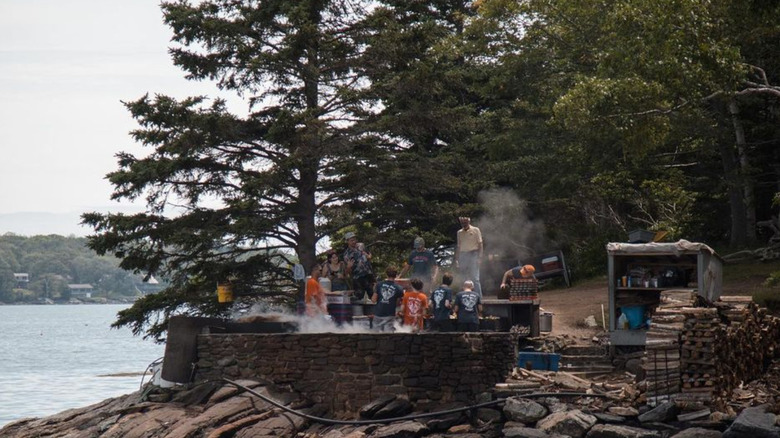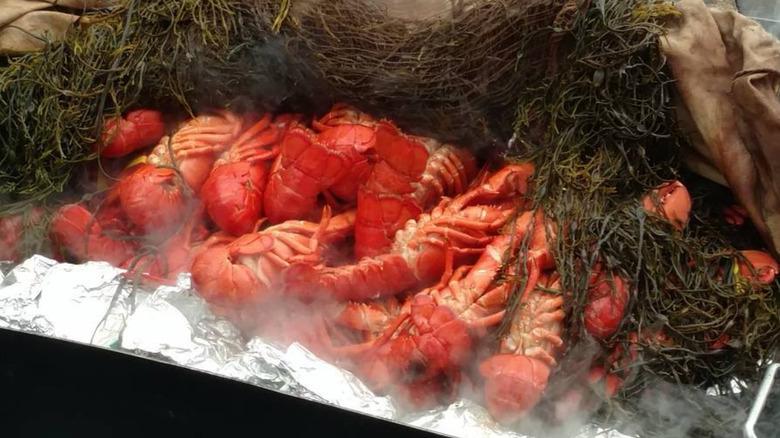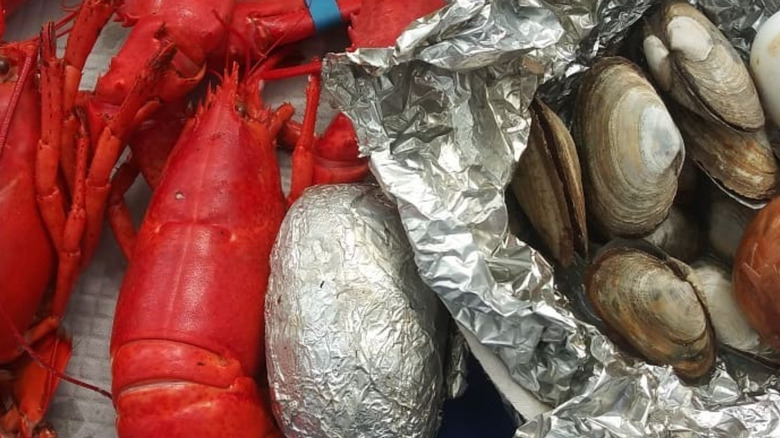The Truth About Cabbage Island
Which island will you visit on your next summer vacation? Hawaii, Turks & Caicos, Martha's Vineyard ... or maybe Cabbage Island? Though the name might not conjure visions of an exciting island excursion, Cabbage Island has an intriguing history, beautiful scenery, and a seafood feast that's to die for.
According to The Russell House Bed & Breakfast, Cabbage Island is a privately-owned island near Boothbay Harbor in Maine. Though it's not known for certain how it got its funny name, the long-held belief is that the island was once known for its large cabbage crops (via Cabbage Island Clam Bakes). The cabbage gardens were rumored to have been covered with masses of seaweed and kelp pulled from the ocean. This practice is a common one in coastal communities, according to Fine Gardening, where locals haul seaweed off the rocky shores where it washes up, then dry it, and work it into soil to add nutrients that benefit all kinds of crops.
Cabbage Island briefly lost its name, regained it, and eventually became very popular for a delicious, seaside culinary tradition. Generations of Downeasters and tourists continue to flock to Cabbage Island to get a taste.
This island has had several owners
The island has always been a draw as a summertime getaway, and a number of families have owned the island over the last two centuries. The Cabbage Island Clam Bakes website shares that the island was originally deeded to members of the Holbrook family in the 1800s by the state of Massachusetts. As The Library of Congress explains, land that now makes up the state of Maine, including the islands off the coast, belonged to Massachusetts until Maine gained statehood in 1820. Cabbage Island stayed in the Holbrook family until 1905, when it was purchased by a Massachusetts dentist. He changed the name to Independence Island and used the spot as a summer home.
Twenty years later the island was sold again, first to a local shipping and grocery store businessman, who added a boathouse and had everything managed by a caretaker. (And paid the caretaker with free groceries.) The next couple of decades would see the renamed island sold yet again, to an individual who ultimately lost the property when he didn't pay his taxes. This opened the door for a new owner to step in, and completely change the island's impact on the Boothbay area.
The 1960s saw the first modern-era Cabbage Island clambakes
After the previous owner of the island defaulted, new buyers stepped forward to claim Cabbage Island, which was still being called Independence Island at that time. According to the Cabbage Island Clambakes website, Donald and Ruth Leavitt bought the island in 1948, paying only what the former owner had owed the state in taxes: $3,600. Nearly a decade later, the Leavitts applied to the Governor of Maine to change the name back to Cabbage Island, and it was made official in 1957.
Around 1960 Cabbage Island changed from a simple and quiet retreat to a mecca for folks who craved an old fashioned clambake. Ruth Leavitt had the idea to host clambakes on the island, and shuttle people over on ferries from the mainland for a twice-a-day feast. Down East Magazine shares that clambakes are a Maine tradition that began hundreds of years ago with the indigenous Wabanaki. The shellfish are cooked by heating rocks in driftwood fires on the beach. Wet seaweed is layered over the hot rocks, and the food placed on top to cook in the steam. Clambakes eventually evolved to include not just clams, but also lobster, and vegetables like potatoes and corn. The Leavitts hosted the popular summertime clambakes on Cabbage Island for 23 years, before deciding to sell the island to a private company in 1983. Unfortunately, no one continued the clambake tradition and the island was left essentially abandoned.
New owners rekindled the tradition
After the Leavitts left Cabbage Island, not much happened there except the occasional boater who motored over to have a picnic or to sightsee (via Cabbage Island Clambakes). One such boater, Wayne Moore, stopped out of curiosity and was intrigued by the island's beauty. According to Maine Magazine, he tracked down the owner and bought Cabbage Island as a spot for his family to enjoy.
Not long after, the Boothbay locals asked Moore to rekindle the famous clambake tradition. Moore loved the idea, and paid a visit Ruth Leavitt at her home in Florida to get her blessing. Not only did she approve, she also gave Moore her famous recipes for clam chowder and blueberry cake. After bringing his brother on board for the idea, Moore bought a boat to ferry people out and named it the Bennie Alice after their mother. In the summer of 1989 Moore hosted his first-ever clambake. At first he continued Leavitt's tradition of seven-days-a-week, twice-daily clambakes, then eventually scaled it back to one bake on weekdays and two per day on weekends.
The Cabbage Island Clambakes are just as popular under Moore as they were with the Leavitts, with people reserving their spots six months or more in advance. Once you know more about these clambakes, you'll understand why.
Cabbage Island is famous for this feast
Why have the clambakes on Cabbage Island been such a draw for generations of Mainers, and flocks of summer tourists? It's not only the huge amount of food you get, but the chance to see the time-honored way all the food is cooked, as food vlogger Mark Weins shared via his YouTube channel.
Many members of the Moore family work on Cabbage Island, including cooking at the steam pits, where Weins showed how they do it. Large wood fires burn under massive metal trays full of boiling sea water. The billowing steam cooks all the food layered above it: corn on the cob, Maine potatoes, hundreds of whole Maine lobsters, and foil wrapped packets of steamer clams. To harness all that steam and add even more briny flavor, heaps of seaweed, still wet from the ocean, are laid over all the food. One unusual part of this clambake are dozens of fresh eggs layered in with the seafood and veggies, which the family explained to Weins is an old-fashioned technique: When the eggs are cooked, they know the rest of the food is steamed to perfection.
Every visitor gets a massive meal: clam chowder, two lobsters, a packet of steamers, corn on the cob, potatoes, onions, plenty of melted butter, and of course, a lobster bib. And for dessert? A slice of Ruth Leavitt's famous, secret recipe blueberry cake. It's a New England seafood feast to remember.
Here's what else you can do on Cabbage Island
The beauty of Cabbage Island is just as enchanting now as it was to the first families who vacationed there in the 1800s. The Cabbage Island Clambake website says that eating isn't the only thing to do there: Either while you wait, or after wolfing down all that lobster, the Moore family invites visitors to "explore every inch" of the five-and-a-half-acre island. The activities include hiking and fishing, games like volleyball and horseshoes, or just relaxing on the shore to watch the boats. There's a lodge, too, with a fireplace for cool days, and a gift shop.
A spot like this would be a no-brainer for a wedding venue, but Moore family members alone get that privilege. Wayne Moore shared with Maine Magazine that organizing weddings for the public would be too much for them to manage, although Cabbage Island and the clambakes are available for rehearsal dinners.
A popular, annual event that Cabbage Island visitors get to enjoy is Boothbay Harbor's Windjammer Days, when the harbor fills with the sails of schooners and historic tall ships. The crew from the ships are invited to Cabbage Island for a celebration clambake with their guests.
With multiple generations pitching in every season since 1989, the Moore family is clearly devoted to keeping the Cabbage Island Clambake tradition alive for a long time to come.
